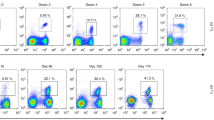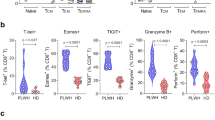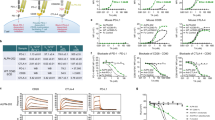Abstract
HIV's considerable capacity to vary its HLA-I-restricted peptide antigens allows it to escape from host cytotoxic T lymphocytes (CTLs). Nevertheless, therapeutics able to target HLA-I-associated antigens, with specificity for the spectrum of preferred CTL escape mutants, could prove effective. Here we use phage display to isolate and enhance a T-cell antigen receptor (TCR) originating from a CTL line derived from an infected person and specific for the immunodominant HLA-A*02-restricted, HIVgag-specific peptide SLYNTVATL (SL9). High-affinity (KD < 400 pM) TCRs were produced that bound with a half-life in excess of 2.5 h, retained specificity, targeted HIV-infected cells and recognized all common escape variants of this epitope. CD8 T cells transduced with this supraphysiologic TCR produced a greater range of soluble factors and more interleukin-2 than those transduced with natural SL9-specific TCR, and they effectively controlled wild-type and mutant strains of HIV at effector-to-target ratios that could be achieved by T-cell therapy.
This is a preview of subscription content, access via your institution
Access options
Subscribe to this journal
Receive 12 print issues and online access
$209.00 per year
only $17.42 per issue
Buy this article
- Purchase on SpringerLink
- Instant access to full article PDF
Prices may be subject to local taxes which are calculated during checkout



Similar content being viewed by others
References
Goulder, P.J. & Watkins, D.I. HIV and SIV CTL escape: implications for vaccine design. Nat. Rev. Immunol. 4, 630–640 (2004).
Sewell, A.K., Price, D.A., Oxenius, A., Kelleher, A.D. & Phillips, R.E. Cytotoxic T lymphocyte responses to human immunodeficiency virus: control and escape. Stem Cells 18, 230–244 (2000).
Phillips, R.E. et al. Human immunodeficiency virus genetic variation that can escape cytotoxic T cell recognition. Nature 354, 453–459 (1991).
Price, D.A. et al. The influence of antigenic variation on cytotoxic T lymphocyte responses in HIV-1 infection. J. Mol. Med. 76, 699–708 (1998).
Cohen, G.B. et al. The selective downregulation of class I major histocompatibility complex proteins by HIV-1 protects HIV-infected cells from NK cells. Immunity 10, 661–671 (1999).
Sewell, A.K., Harcourt, G.C., Goulder, P.J., Price, D.A. & Phillips, R.E. Antagonism of cytotoxic T lymphocyte-mediated lysis by natural HIV-1 altered peptide ligands requires simultaneous presentation of agonist and antagonist peptides. Eur. J. Immunol. 27, 2323–2329 (1997).
Crawford, H. et al. Compensatory mutation partially restores fitness and delays reversion of escape mutation within the immunodominant HLA-B*5703-restricted Gag epitope in chronic human immunodeficiency virus type 1 infection. J. Virol. 81, 8346–8351 (2007).
Friedrich, T.C. et al. Reversion of CTL escape-variant immunodeficiency viruses in vivo. Nat. Med. 10, 275–281 (2004).
Leslie, A.J. et al. HIV evolution: CTL escape mutation and reversion after transmission. Nat. Med. 10, 282–289 (2004).
Martinez-Picado, J. et al. Fitness cost of escape mutations in p24 Gag in association with control of human immunodeficiency virus type 1. J. Virol. 80, 3617–3623 (2006).
Brander, C. et al. Lack of strong immune selection pressure by the immunodominant, HLA-A*0201-restricted cytotoxic T lymphocyte response in chronic human immunodeficiency virus-1 infection. J. Clin. Invest. 101, 2559–2566 (1998).
Goulder, P.J. et al. Substantial differences in specificity of HIV-specific cytotoxic T cells in acute and chronic HIV infection. J. Exp. Med. 193, 181–194 (2001).
Goulder, P.J. et al. Patterns of immunodominance in HIV-1-specific cytotoxic T lymphocyte responses in two human histocompatibility leukocyte antigens (HLA)-identical siblings with HLA-A*0201 are influenced by epitope mutation. J. Exp. Med. 185, 1423–1433 (1997).
Morikawa, Y., Zhang, W.H., Hockley, D.J., Nermut, M.V. & Jones, I.M. Detection of a trimeric human immunodeficiency virus type 1 Gag intermediate is dependent on sequences in the matrix protein, p17. J. Virol. 72, 7659–7663 (1998).
Iversen, A.K. et al. Conflicting selective forces affect T cell receptor contacts in an immunodominant human immunodeficiency virus epitope. Nat. Immunol. 7, 179–189 (2006).
Kan-Mitchell, J. et al. Degeneracy and repertoire of the human HIV-1 Gag p1777–85 CTL response. J. Immunol. 176, 6690–6701 (2006).
Martinez-Hackert, E. et al. Structural basis for degenerate recognition of natural HIV peptide variants by cytotoxic lymphocytes. J. Biol. Chem. 281, 20205–20212 (2006).
Wilson, J.D. et al. Oligoclonal expansions of CD8+ T cells in chronic HIV infection are antigen specific. J. Exp. Med. 188, 785–790 (1998).
Li, Y. et al. Directed evolution of human T-cell receptors with picomolar affinities by phage display. Nat. Biotechnol. 23, 349–354 (2005).
Holler, P.D., Lim, A.R., Cho, B.K., Rund, L.A. & Kranz, D.M. CD8− T cell transfectants that express a high affinity T cell receptor exhibit enhanced peptide-dependent activation. J. Exp. Med. 194, 1043–1052 (2001).
Darden, J.M. et al. A flow cytometric method for measuring neutralization of HIV-1 subtype B and E primary isolates. Cytometry 40, 141–150 (2000).
McCune, J.M. The dynamics of CD4+ T-cell depletion in HIV disease. Nature 410, 974–979 (2001).
Edwards, C.T., Pfafferott, K.J., Goulder, P.J., Phillips, R.E. & Holmes, E.C. Intrapatient escape in the A*0201-restricted epitope SLYNTVATL drives evolution of human immunodeficiency virus type 1 at the population level. J. Virol. 79, 9363–9366 (2005).
Whelan, J.A. et al. Specificity of CTL interactions with peptide-MHC class I tetrameric complexes is temperature dependent. J. Immunol. 163, 4342–4348 (1999).
Cole, D.K. et al. Human TCR-binding affinity is governed by MHC class restriction. J. Immunol. 178, 5727–5734 (2007).
Molloy, P.E., Sewell, A.K. & Jakobsen, B.K. Soluble T cell receptors: novel immunotherapies. Curr. Opin. Pharmacol. 5, 438–443 (2005).
Betts, M.R. et al. HIV nonprogressors preferentially maintain highly functional HIV-specific CD8+ T cells. Blood 107, 4781–4789 (2006).
Zimmerli, S.C. et al. HIV-1-specific IFN-gamma/IL-2-secreting CD8 T cells support CD4-independent proliferation of HIV-1-specific CD8 T cells. Proc. Natl. Acad. Sci. USA 102, 7239–7244 (2005).
Purbhoo, M.A., Irvine, D.J., Huppa, J.B. & Davis, M.M. T cell killing does not require the formation of a stable mature immunological synapse. Nat. Immunol. 5, 524–530 (2004).
Suhoski, M.M. et al. Engineering artificial antigen-presenting cells to express a diverse array of co-stimulatory molecules. Mol. Ther. 15, 981–988 (2007).
Acknowledgements
We are grateful to R. Ashfield, B. Classon and R. Vonderheide for their help in initiating collaborations. We thank P. Goulder, A. Leslie and T. Scriba for encouragement, critical reading of the manuscript and helpful suggestions. A. Bennett designed the TCR expression constructs. M. Milone confirmed the SL9 sequence of 92BR-017, 92BR-018 and 92BR-028. A.K.S. was a Wellcome Trust Senior Fellow and is funded by Cardiff University. This work was also supported in part by US National Institutes of Health grants R21 AI060477, R01 CA105216 and PO1 AI066290. The authors would like to dedicate this study to the memory of our colleague and friend Jonathan Michael Boulter, who contributed immensely in the field of soluble T cell receptors.
Author information
Authors and Affiliations
Contributions
A.V.-R., M.M.S. and R.G.C. performed the TCR gene transfer experiments in the laboratories of C.H.J. and J.L.R. P.E.M., S.M.D. and Y.L. undertook the phage display selection. B.J.C., S.M.D. and R.M. made the MHC and TCR proteins. A.V., T.M. and D.K.C. performed the surface plasmon resonance. D.H.S. and M.A.P. performed the microscopic analyses. A.M. and B.L. undertook the experiments with primary T cells grown by A.K.S. R.E.P. secured the clinical materials. B.K.J., A.K.S. and J.L.R. conceived and wrote the study.
Corresponding authors
Supplementary information
Supplementary Text and Figures
Supplementary Figures 1–6, Supplementary Tables 1–2 and Supplementary Methods (PDF 3368 kb)
Rights and permissions
About this article
Cite this article
Varela-Rohena, A., Molloy, P., Dunn, S. et al. Control of HIV-1 immune escape by CD8 T cells expressing enhanced T-cell receptor. Nat Med 14, 1390–1395 (2008). https://doi.org/10.1038/nm.1779
Received:
Accepted:
Published:
Issue Date:
DOI: https://doi.org/10.1038/nm.1779
This article is cited by
-
Rapid screening of TCR-pMHC interactions by the YAMTAD system
Cell Discovery (2022)
-
Toll-like receptor agonist therapy can profoundly augment the antitumor activity of adoptively transferred CD8+ T cells without host preconditioning
Journal for ImmunoTherapy of Cancer (2016)
-
Increased T cell breadth and antibody response elicited in prime-boost regimen by viral vector encoded homologous SIV Gag/Env in outbred CD1 mice
Journal of Translational Medicine (2016)
-
Elimination of Latently HIV-infected Cells from Antiretroviral Therapy-suppressed Subjects by Engineered Immune-mobilizing T-cell Receptors
Molecular Therapy (2016)
-
Direct molecular mimicry enables off-target cardiovascular toxicity by an enhanced affinity TCR designed for cancer immunotherapy
Scientific Reports (2016)



